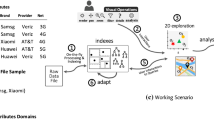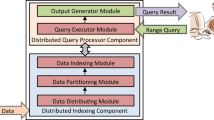Abstract
Indexing is one of the most important techniques to facilitate query processing over a multi-dimensional dataset. A commonly used strategy for such indexing is to keep the tree-structured index balanced. This strategy reduces query processing cost in the worst case, and can handle all different queries equally well. In other words, this strategy implies that all queries are uniformly issued, which is partially because the query distribution is not possibly known and will change over time in practice. A key issue we study in this work is whether it is the best to fully rely on a balanced tree-structured index in particular when datasets become larger and larger in the big data era. This means that, when a dataset becomes very large, it becomes unreasonable to assume that all data in any subspace are equally important and are uniformly accessed by all queries at the index level. Given the existence of query skew and the possible changes of query skew, in this paper, we study how to handle such query skew and such query skew changes at the index level without sacrifice of supporting any possible queries in a wellbalanced tree index and without a high overhead. To tackle the issue, we propose index-view at the index level, where an index-view is a short-cut in a balanced tree-structured index to access objects in the subspaces that are more frequently accessed, and propose a new index-view-centric framework for query processing using index-views in a bottom-up manner. We study index-views selection problem in both static and dynamic setting, and we confirm the effectiveness of our approach using large real and synthetic datasets.
Similar content being viewed by others
References
Guttman A. R-trees: a dynamic index structure for spatial searching. In: Proceedings of ACM Special Interest Group on Management of Data. 1984, 47–57
Finkel R A, Bentley J L. Quad trees: a data structure for retrieval on composite keys. Acta Informatica, 1974, 4(1): 1–9
Bentley J L. Multidimensional binary search trees used for associative searching. Communications of the ACM, 1975, 18(9): 509–517
Samet H. Foundations of Multidimensional and Metric Data Structures. San Francisco, CA: Morgan Kaufmann, 2006
Silva-Filho Y V. Average case analysis of region search in balanced k-d trees. Information Processing Letters, 1979, 8(5): 219–223
Silverstein C, Henzinger M R, Marais H, Moricz M. Analysis of a very large web search engine query log. SIGIR Forum, 1999, 33(1): 6–12
Gonzalez M C, Hidalgo C A, Barabasi A L. Understanding individual human mobility patterns. Nature, 2008, 453(7196): 779–782
Yuan J, Zheng Y, Zhang C Y, Xie W L, Xie X, Sun G Z, Huang Y. Tdrive: driving directions based on taxi trajectories. In: Proceedings of the 18th SIGSPATIAL International Conference on Advances in Geographic Information Systems. 2010, 99–108
Levandoski J J, Sarwat M, Eldawy A, Mokbel M F. Lars: a locationaware recommender system. In: Proceedings of the 28th IEEE International Conference on Data Engineering. 2012, 450–461
Lee R, Wakamiya S, Sumiya K. Discovery of unusual regional social activities using geo-tagged microblogs. World WideWeb, 2011, 14(4): 321–349
Arya S, Mount D M, Netanyahu N S, Silverman R, Wu A Y. An optimal algorithm for approximate nearest neighbor searching. In: Proceedings of the 5th ACM-SIAM Symposium on Discrete Algorithms. 1994, 573–582
Roy S B, Chakrabarti K. Location-aware type ahead search on spatial databases: semantics and efficiency. In: Proceedings of the ACM SIGMOD International Conference on Management of Data. 2011, 361–372
Friedman J H, Bentley J L, Finkel R A. An algorithm for finding best matches in logarithmic expected time. ACM Transactions on Mathematical Software, 1977, 3(3): 209–226
Papadias D, Shen QM, Tao Y F, Mouratidis K. Group nearest neighbor queries. In: Proceedings of the 20th IEEE International Conference on Data Engineering. 2004, 301–312
Felipe I D, Hristidis V, Rishe N. Keyword search on spatial databases. In: Proceedings of the 24th IEEE International Conference on Data Engineering. 2008, 656–665
Cong G, Jensen C S, Wu D M. Efficient retrieval of the top-k most relevant spatial Web objects. The Proceedings of the VLDB Endowment, 2009, 2(1): 337–348
Cao X, Cong G, Jensen C S, Ooi B C. Collective spatial keyword querying. In: Proceedings of ACM SIGMOD International Conference on Management of Data. 2011, 373–384
Li G L, Feng J H, Xu J. Desks: direction-aware spatial keyword search. In: Proceedings of the 28th IEEE International Conference on Data Engineering. 2012, 474–485
Sheng C, Tao Y F. FIFO indexes for decomposable problems. In: Proceedings of the 30th ACM SIGMOD-SIGACT-SIGART Symposium on Principles of Database Systems. 2011, 25–35
Hjaltason G R, Samet H. Distance browsing in spatial databases. ACM Transactions on Database Systems, 1999, 24(2): 265–318
Nemhauser G L, Wolsey L A, Fisher M L. An analysis of approximations for maximizing submodular set functions. Mathematical Programming, 1978, 14(1): 265–294
Feige U. A threshold of ln n for approximating set cover. Journal of the ACM, 1998, 45(4): 634–652
Sviridenko M. A note on maximizing a submodular set function subject to a knapsack constraint. Operations Research Letters, 2004, 32(1): 41–43
Berinde R, Cormode G, Indyk P, Strauss M J. Space-optimal heavy hitters with strong error bounds. In: Proceedings of ACM SIGMODSIGACT-SIGART Symposium on Principles of Database Systems. 2009, 157–166
Metwally A, Agrawal D, El Abbadi A. Efficient computation of frequent and top-k elements in data streams. In: Proceedings of International Conference on Database Theory. 2005, 398–412
Cudré-Mauroux P, Wu E, Madden S. Trajstore: an adaptive storage system for very large trajectory data sets. In: Proceedings of the 26th IEEE International Conference on Data Engineering. 2010, 109–120
Achakeev D, Seeger B, Widmayer P. Sort-based query-adaptive loading of R-trees. In: Proceedings of the 21st ACM International Conference on Information and Knowledge Management. 2012, 2080–2084
Sleator D D, Tarjan R E. Self-adjusting binary search trees. Journal of the ACM, 1985, 32(3): 652–686
Park E, Mount D M. A self-adjusting data structure for multidimensional point sets. In: Proceedings of European Symposium on Algorithms. 2012, 778–789
Idreos S, Kersten M L, Manegold S. Database cracking. In: Proceedings of Innovative Data Systems Research. 2007, 68–78
Tzoumas K, Yiu ML, Jensen C S. Workload-aware indexing of continuously moving objects. Proceedings of the VLDB Endowment, 2009, 2(1): 1186–1197
Acknowledgements
This work was supported by grant of the Research Grants Council of the Hong Kong SAR, China (14209314).
Author information
Authors and Affiliations
Corresponding author
Additional information
Weihuang Huang received her BS and MS degrees from Tsinghua University, China in 2010 and 2013. She is currently a PhD student at the Department of Systems Engineering and Engineering Management in The Chinese University of Hong Kong, China. Her main research interest is indexing.
Jeffrey Xu Yu has held teaching positions at the Institute of Information Sciences and Electronics, University of Tsukuba, Japan, and at the Department of Computer Science, Australian National University, Australia. Currently, he is a professor in the Department of Systems Engineering and Engineering Management, the Chinese University of Hong Kong, China.
Zechao Shang received his PhD degree from The Chinese University of Hong Kong (CUHK), China in 2015. He is currently a postdoctoral fellow at the Department of Systems Engineering and Engineering Management, CUHK. His main research interest is large scale graph data processing system.
Electronic supplementary material
Rights and permissions
About this article
Cite this article
Huang, W., Yu, J.X. & Shang, Z. Handling query skew in large indexes: a view based approach. Front. Comput. Sci. 12, 146–162 (2018). https://doi.org/10.1007/s11704-016-5525-3
Received:
Accepted:
Published:
Issue Date:
DOI: https://doi.org/10.1007/s11704-016-5525-3




